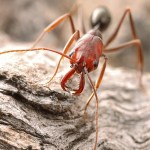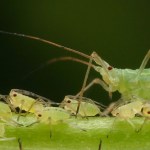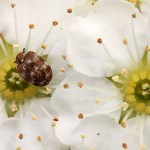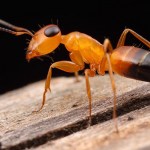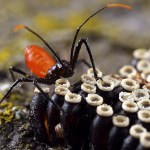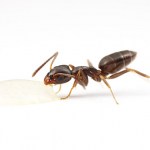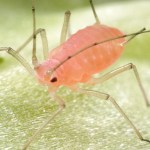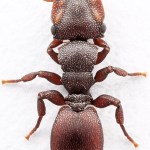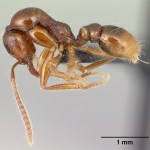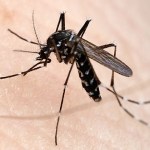
What is this odd little beast?
Five points each for the first person to pick the order and the family.
The cumulative points winner for the month of May will win either 1) any 8x10 print from my insect photo galleries, or 2) a guest blog post on the (safe-for-work) topic of their choosing.
...because badass mandibles are in style this season:
Odontomachus turneri, Australia
photo details:
Canon EOS 50D camera
Canon MP-E 65mm 1-5x macro lens
ISO 100, f/13, 1/250sec
Dandelion through the eyes of a macro-adapted iPhone 3G
Nothing warms the heart of a blogger more than birthing a meme. A couple weeks ago I posted a short article on how a hand lens can enable a cell phone to do macrophotography. Other bloggers have taken to the idea and have been posting their results. Here are some of them:
Microecos
Highly Allochthonous
Mountain Beltway
Looking for Detachment
A: If, at birthday parties, the featured game is "pin-the-stinger-on-the-bee."
your intrepid blogger, circa 1985
You may thank my mother for sending along this, um, interesting photo.
Anthrenus sp. carpet beetle
Urbana, Illinois
Little Anthrenus beetles are one of the most common insects across the northern hemisphere. Adults can be found in flowers feasting on pollen, and the detritivorous larvae are often inhabitants of homes and buildings. If you'd like to see one of these yourself, check your window sills- there's a good chance a few will have accumulated around the edges as they try to exit.
A few years ago I attended an organizational meeting for the great Beetle Tree of Life project. A couple dozen of the world's greatest Coleopterists were crammed into a room…
New this week at alexanderwild.com we have photographs of the Savanna Strobe Ant Opisthopsis haddoni. These delightfully perky insects inhabit open environments in northern Australia and are one of my favorite ants.
Opisthopsis has excellent vision. The location of the compound eyes atop the head allows it to spot a photographer approaching from any direction and take appropriate evasive action. This wasn't the easiest ant to shoot.
The peculiarly erratic style of walking is also not conducive to photography. The common name "strobe ant" refers to this ant's unpredictable little fits and…
From the "I-never-thought-I'd-use-this-class" file, I took a semester course once from an oil spill expert. Professor Ed Gilfillan had studied the response of Prince William Sound to various clean-up regimens following the wreck of the Exxon Valdez, and we spent weeks learning about chemistry of oil spills and the factors involved in ecological recovery. The class was over 15 years ago, mind you, and in retrospect I remember only two things.
But these are two very key things, and they are both relevant to the ongoing tragedy in the Gulf of Mexico.
1. The soil structure at the coastline will…
They looked like little flowers, or miniature suction cups, but yesterday's mystery was neither. Here's a more recent view:
Arilus cristatus, a newly hatched wheel bug nymph with eggs
Ted MacRae of Beetles in the Bush picks up 6 points for guessing that they were Reduviid eggs, and MarekB gets 4 for nabbing the genus and species. Plus, one point goes to Chris Grinter who surmised that these might be hemipteran eggs.
By late summer this little buglet will have grown into a wheel bug, a massive assassin as large as my thumb:
An amazing photo posted this week at Antweb shows a developing male Cerapachys ant inside the silken cocoon:
(Image by Erin Prado)
What's this?
2 points for naming the structure, 4 for family, and 4 for genus/species.
The cumulative points winner for the month of May will win either 1) any 8x10 print from my insect photo galleries, or 2) a guest blog post on the (safe-for-work) topic of their choosing.
How did they catch this footage of an ANTi-pesticide protest? Here's a peek behind the scenes.
Take a photograph, of course:
Tapinoma sessile, the odorous house ant
photo details:
Canon EOS 50D camera
Canon MP-E 65mm 1-5x macro lens
ISO 100, f/13, 1/250sec
A pleasingly pink pea aphid (Acrythosiphon pisum)
A long time ago, on a host plant far, far away, an aphid became infected with a fungus. And then it did something unusual: it incorporated some fungal genes into its own genome.
New research by Nancy Moran and Tyler Jarvik, published yesterday in the journal Science, used the newly-published pea aphid genome to demonstrate that the genes the aphids use to make pink carotenoid pigments are derived not from insects but from a gene lineage nested well within the fungi.
This observation is interesting for two points. First, most animals with…
Podabrus sp. Soldier Beetle
Urbana, Illinois
Last week we featured a larval soldier beetle. Today we have an adult of the same family (Cantharidae), in the genus Podabrus.
photo details:
Canon EOS 50D camera
Canon MP-E 65mm 1-5x macro lens
ISO 100, f/13, 1/250sec
Blog posts are long, thin things.
One could, for example, use a blog to post a high-resolution map of Chile. Or a single strand of spagetti. Any image up to 500 pixels wide, for as long as it goes. In that vein, here's a Cephalotes varians turtle ant:
Just wait until I find a stick insect.
Yesterday, Antweb posted its first images of Anomalomyrma workers, and I've been staring at them ever since.
This is a strange ant indeed, a member of the ancient subfamily Leptanillinae that is potentially a sister lineage to the remaining extant ants. It's ostensibly a subterranean predator in the forests of tropical Asia, but beyond that little is known. The number of times Anomalomyrma has been collected can probably be counted on my fingers.
Here's a pic:
Call me crazy, but the shape of this thing puts me in mind of another ant oddity: Martialis heureka:
Martialis was discovered in…
What was that dazzling sequence of nucleotide bases? Here's a more holistic view:
Aedes albopictus, the Asian Tiger Mosquito
The gene was ribonucleotide reductase, which is essential for DNA synthesis. If you followed the BLAST results back through to the paper where this sequence was published, you'll see that the researchers were interested in this gene because some of their mosquito cell lines were showing resistance to a chemical, hydroxyurea, that is used to synchronize cell cultures. This gene was linked to the resistance, and sequencing it allowed them to see that copy number, rather…
The U.K.-based film company Ammonite has been blogging their ant-filming experiences in Costa Rica and Spain. The glamor of making nature documentaries apparently includes skin parasites and volcano-related travel limbo.
The journal Myrmecological News has a trio of new articles, including descriptions of two new myrmicine species.
Ted MacRae thinks ant taxonomy is entirely too complicated and proposes an alternative.
Ant developmental biologist Ehab Abouheif is featured in a short but excellent documentary (French language). (h/t Archetype).
Marvel's Ant-Man inches closer to the big screen…

